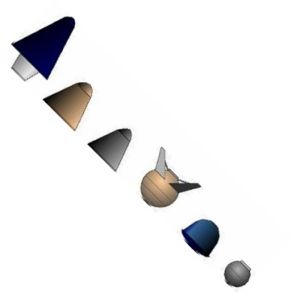
Home - Search - Browse - Alphabetic Index: 0- 1- 2- 3- 4- 5- 6- 7- 8- 9
A- B- C- D- E- F- G- H- I- J- K- L- M- N- O- P- Q- R- S- T- U- V- W- X- Y- Z
Lockheed Project 7969
 Project 7969 Designs Project 7969 ballistic designs. From left: Lockheed; Martin; Aeronutronics; Goodyear; McDonnell; Convair Credit: © Mark Wade |
Status: Study 1958. Gross mass: 1,400 kg (3,000 lb). Height: 4.26 m (13.97 ft).
The capsule would be launched by an Atlas-Hustler combination into a 480 km orbit for a 4 hour mission.
Tracking would use the Minitrack System and deorbit would be accomplished by retrorocket providing a 60 m/sec braking impulse. Spacecraft attitude control was by rocket thrusters and electrically-powered motors. The spacecraft was automatic and no pilot intervention was required. Maximum G-forces during re-entry were 8 g's and either ablative or beryllium heat shields could be used. In case of booster failure during ascent to orbit the capsule would eject from the booster. The spacecraft had a ballistic coefficient (W/CdA) of 500 kg per square meter. Landing precision was within a 650 x 30 km footprint. It was expected that a first manned orbital flight could be achieved 24 months after a go-ahead at a cost of $ 10-100 million.
Family: Manned spacecraft. Country: USA. Launch Vehicles: Atlas, Atlas Agena A. Agency: USAF, Lockheed. Bibliography: 26, 483, 59.
Back to top of page
Home - Search - Browse - Alphabetic Index: 0- 1- 2- 3- 4- 5- 6- 7- 8- 9
A- B- C- D- E- F- G- H- I- J- K- L- M- N- O- P- Q- R- S- T- U- V- W- X- Y- Z
© 1997-2019 Mark Wade - Contact
© / Conditions for Use